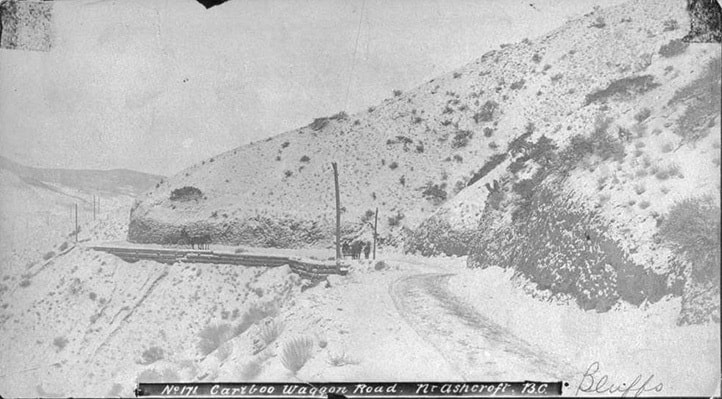In 1863, a year after the Cornwall brothers arrived and established Ashcroft on the new Cariboo Wagon Road from Yale, pre-emptors John Barnes and William Brink had established ranches along the Thompson River, stretching from what is now downtown Ashcroft north past where the Ashcroft Terminal now sits. By 1883 William Brink had died, and Barnes had partnered with newcomer Oliver Evans.
A survey team searching out a route for the Canadian Pacific Railway had been through the area in 1872, and the men knew that the line would be passing close to the Thompson River east of what was then called Ashcroft (now Ashcroft Manor). Furthermore, they knew that the CPR was planning to locate a station and depot in the area, which was the only place in the region with easy and close access to the wagon road. As the northernmost station and depot in the province, the place that the railway finally chose would become an important transportation hub.
Barnes and Evans decided to build a hotel, which would cater to the traffic they anticipated would come through on the railroad when it was built. This was no small undertaking, at a time when the road to Ashcroft that branched off the Cariboo Wagon Road at what is now Boston Flats was perilous at best. Everything they needed to build and furnish a hotel—from crockery and bedding to liquor and furniture—needed to be brought up the wagon road, then transported along the rough and rocky road to the hotel site.
Just how difficult and perilous a task this was is vividly documented in an account of the descent to Ashcroft in August 1883, as young Bob Walker, guiding seven span of oxen carrying goods to outfit the new hotel, confronted the prospect before him.
His route into what would become Ashcroft followed the road that had been established by the Harper brothers of Clinton, who had decided, just a few years earlier, to relocate their mill to where the Bonaparte River met the Thompson. They, along with others, had built a road that linked up with the Cariboo Wagon Road to the west, and extended east to the site of their new mill, around a series of bluffs and then down a steep hill to a gully that led to the mill.
“Bob came to a slow halt and looked down the steep sandy hill in front. Bill Bose, his boss, had told him to wait here until Bill himself arrived to superintend the descent. Far below the Thompson River flowed serenely toward the sea, uncaring that young Bob had a town to chaperone.

Bill Bose. Ashcroft Museum and Archives
“It was so hot that the air seemed to sizzle. Here was the heart of the sagebrush country in the Cariboo. Down below near the river’s edge the grain fields on the flats were bursting into an inviting yellow. The recently completed wagon road fell steeply down a winding gully toward the cool waters. Bob decided he would show old Bill that nothing was too steep for him. So he walked to the wagons and pulled the rope that set the great brakes, then swung his whip. ‘Giddup!’ he said.
“With shout and whip, he made the lead oxen cross the side of the gully, so that the heavy span at the pole far behind could make the hairpin turn. Had they swung too sharply or moved too quickly, pole, oxen, and wagons would have been driven into the bank, and some 16,000 pounds of crockery, stoves, furniture, timbers, and whisky would have tumbled over the ground when the wagons turned over. That would have meant not only broken dishes and a delay in building operations, but young Bob would be confronted with an angry Bill Bose, something for a cautious young fellow to avoid.
“Creaking, squeaking, grinding, the cavalcade wound gingerly down the steep grade, the last wagon always ponderously tracking the very edge of the road, sometimes with a drop of scores of feet just missed by inches, sometimes so crowded against a sandbank that an upset seemed inevitable. When they reached the flats at the water’s edge, Bob heaved a sigh of relief. Here was at last a little wind. It waved the grain in the fields across the river. Bob and Bill Bose would unload and put the contents of the great wagons on boats tomorrow and ferry them across the Thompson.
“Well, Bill Bose, best-known driver of ox teams in those parts, gave Bob the calling down of his life when he finally turned up. Next day the town was ferried across, and dragged up a sandbank to the site. Not far off would run Canadian Pacific Railway tracks when the transcontinental reached that far west. For Bill Bose’s wagons contained lumber, dishes, and whisky for a hotel, and Ashcroft started as simply as a hotel.”
“The site” was probably the low, level stretch on the east side of the Thompson where the River Inn is now located. It was almost certainly chosen as the place to situate a hotel because Barnes and Evans thought that the railway line would run close to the river, and the hotel would thus be ideally situated.
As Robbie Burns said, however, the best laid plans “gang aft agley” (or oft go awry). When, in 1885, the CP chose a slightly different route—one that kept it away from the river, and more to the centre of the flat land abutting it—Barnes and Evans came up with a solution. Since the mountain (the CPR tracks) would not come to Muhammad (the hotel), Muhammad would go to the mountain. In true pioneer spirit, they disassembled the hotel, and using a windlass and mules moved it lock, stock, and barrel to a site directly across from where the CPR station was built; the site where the post office stands today (the station was where the Fields store now is).
